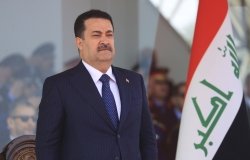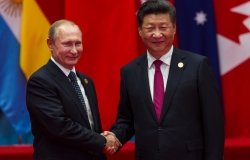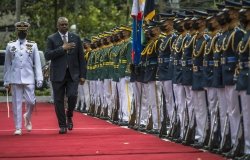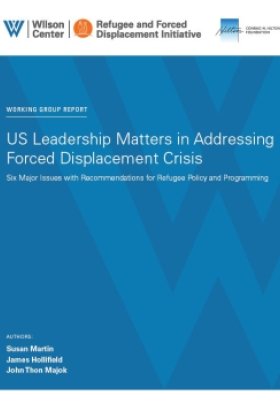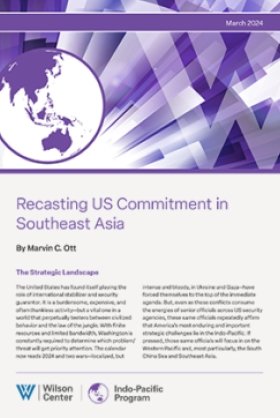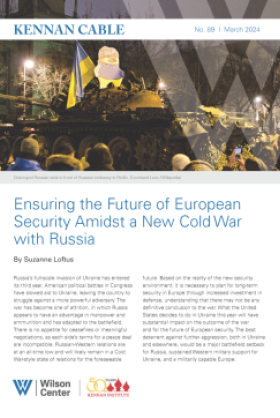'U.S. Policy Toward the Baltic States': Matthew Rojansky Testifies Before House Foreign Affairs Subcommittee on Europe, Eurasia and Emerging Threats
Director of the Kennan Institute Matthew Rojansky testified before the U.S. House Committee on Foreign Affairs on the topic of U.S. Policy Toward the Baltic States.
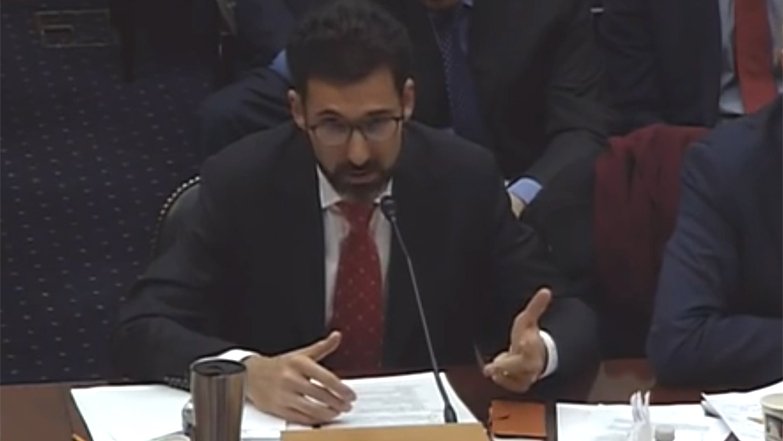
Testimony as Prepared
Russia-NATO Tensions in the Baltic Region and Beyond
I want to thank you, Mr. Chairman and Mr. Meeks, for holding this hearing today to devote time to a discussion of U.S. national security and foreign policy interests vis-a-vis Russia and our NATO allies in the Baltic region. These are, without any doubt, important topics, which although much in the news over the past several years, have not received adequate consideration through exactly the kind of sober discourse and inclusive debate that this setting makes possible. I am very grateful for the opportunity to participate here.
Let me now add the disclaimer that my testimony here today is in my personal expert capacity, and that nothing I say purports to represent official views of the Kennan Institute, the Woodrow Wilson International Center for Scholars, or the United States Government. I add that last point of disclaimer by way of once again thanking you and your colleagues here on Capitol Hill, and underscoring that the Wilson Center is, in fact, the Congressionally-chartered national memorial to our 28th President, a scholar of international relations, and the only U.S. President to hold a Ph.D.. So although my views are my own, my presence at a hearing like this and our other work in support of you and your colleagues and staff, advances the Wilson Center’s non-partisan mission of “independent research and open dialogue to inform actionable ideas for the policy community.” Ok, end of disclaimer and commercial.
The Context
I’ve been a frequent visitor in the Baltic States and the wider region, including Russia, Ukraine, and Belarus, and I follow closely the media and expert publications coming out of the region, as well as relevant reports in the local and international press. In 2015, during the run-up to NATO’s Warsaw summit, I served as a visiting Research Scholar at the NATO Defense College. Moreover, in my capacity as Director of the Kennan Institute, I have had the privilege to host here in Washington many researchers working specifically on topics related to the security and development of the Baltic States, and on Russia-NATO relations in the region stretching from the Arctic to the Black Sea. I will base my testimony here in part on my firsthand observation, as well as on the outstanding research of these scholars and others.
The concerns of the Baltic States as they have been described by my colleagues, the press, and the Baltic governments are real, not imagined, and they are based on historical experience, as well as present security and political realities. I can confirm based on discussions with Russian experts and my reading of Russian sources that, as seen from Moscow, most of the states of the so-called “near abroad,” from former Soviet Central Asia to Ukraine, the Caucasus and even the Baltics, are seen as less than fully sovereign. These states fall within an inner ring of close scrutiny and pressure from Moscow.
That said, there is a pronounced difference in Russian perceptions between the Baltic States, which are EU and NATO members, and other former Soviet republics. The task here is to assess how Russians view NATO’s enhanced presence in the Baltic region, and what, if anything, recent Russian statements and behavior tell us about Moscow’s possible intentions going forward. As we undertake that assessment, let us clearly recognize our limitations: we can neither predict the future, nor read Mr. Putin’s mind.
Breaking down the problem
What we can do is study patterns, and try to extract lessons. One key pattern is that for a threat of harm to be realized, it generally must represent the confluence of three main factors: an actor’s motive to do harm, an actor’s capability to inflict harm, and the opportunity to do so—motive, capability, and opportunity. This is the basic three-part framework I will adopt in assessing the threat or potential threat of Russian action against the Baltic States.
In the context of complex internal diplomacy within the NATO alliance, and within bilateral relationships between the U.S. and its European allies, it is especially important to try to establish common reference points for analyzing the threats and challenges we face, and for assessing what may be the appropriate response. That can be difficult since where you sit—or in this case where you lie on the map—has a big effect on where you stand in terms of threat perceptions and priorities. But it does not serve U.S. interests for the transatlantic community to be divided along geographic or other lines, so examining and refining our common understanding of this complex issue is a decidedly worthwhile effort.
Russia’s Motives
Let us first consider the question of motive—why might Moscow seek to interfere in the Baltic region, and why not? Certainly, the most acute fears of those in the Baltic States and beyond that Russia may seek to intervene were exacerbated by Russia’s military actions against Georgia in 2008 and against Ukraine in 2014, both with continuing consequences for the sovereignty and stability of those countries. Russia continues to support separatists in Moldova’s breakaway Transnistria region, and has shown an increasing willingness to meddle in the domestic politics of even well-established Western democracies, such as Germany and France. The allegations of Russian hacking and meddling in the 2016 U.S. election deepen this concern.
For security officials and political leaders in the Baltic States, none of this is new. Their view of Russia’s hostile motives has been shaped by experience. Consider the 2007 cyber-attacks on Estonian state servers amid a dispute over the Bronze Soldier of Tallinn, and the kidnapping in September 2014 of Estonian security officer Eston Kohver by Russian agents; accusations by Latvian officials that Russia has mounted a vast and sophisticated disinformation campaign to sway the votes of some half a million Russian speakers in the country in recent and upcoming elections; and the statement by the head of Lithuania’s Counter-Intelligence State Security Department, Darius Jauniskis that, “we are already at war, and for many years.”[1]
It should be beyond doubt that Russians view the Baltic States as fair game for the kind of cyber and information operations that are becoming the new normal in what has been called “hybrid” conflict between Russia and the West. In the context of Russia’s own “new generation warfare” doctrine, it is not unreasonable to assume that such non-kinetic tactics may be a prelude or a corollary to an armed attack. At the same time, Russian sources consistently deny any intention to escalate to the level of aggressive military action, let alone the type of invasion or occupation that has been much discussed and much feared among NATO allies.
Russia has both broad and deep ties with the Baltic States, especially with the region’s commercial hubs, such as Latvia’s capital Riga, and with heavily ethnic Russian enclaves, such as Narva in Estonia. Russian experts describe their interests in the Baltic States as diverse and varied, but they identify three common elements. First, they acknowledge fears about U.S. foreign policy objectives in the region—fears which have been magnified by the increased U.S. and NATO attention to the region. Second, they seek to maintain a stable status quo in political and economic relations, including clearly demarcated borders, unimpeded access to the Russian exclave of Kaliningrad, and restoration of modest but important trade ties with each of the Baltic States, which have been constrained by E.U. sanctions following the Ukraine crisis and Russian counter-sanctions.
The third significant Russian interest in the Baltic States—asserting the right to protect Russian speakers abroad—is a source of acute concern. In 2008, then-Russian President Dmitry Medvedev claimed a sphere of “privileged” influence around Russia’s borders, which many understood to include the Baltic region, while a major theme of Vladimir Putin’s third presidential term, since 2012, has been championing the interests of the so-called “Russian World,” including his assertion that some 25 million ethnic Russians were left outside Russia’s borders when the Soviet Union collapsed in 1991. In the run-up to Russia’s invasion of Ukraine, and afterward, Russian officials have talked of the need to protect Russian speakers outside Russia, including in the Baltic States.
During a meeting with Russian speakers in Riga in 2014, Russia’s Foreign Ministry Commissioner for Human Rights, Democracy and the Rule of Law Konstantin Dolgov said: “It has to be stated with sadness that a huge number of our compatriots abroad, whole segments of the Russian world, continue to face serious problems in securing their rights and lawful interests….One of the obvious and, perhaps, key reasons for this state of affairs is the unrelenting growth of xenophobic and neo-Nazi sentiments in the world.” He added: “We will not tolerate the creeping offensive against the Russian language that we are seeing in the Baltics.”[2]
Still, official Russians generally eschew explicit threats of military intervention in the Baltic States to protect Russian speakers, and some Russian observers make an effort to distinguish the Baltic case from that of Crimea, where protection of Russian speakers was Moscow’s main justification for use of force. Dmitry Trenin, a former Russian military officer and political analyst at the Carnegie Moscow Center, describes Russia’s interest as “not a question of potential influence on the Baltic States,” but “simply a question of national prestige. Why are Russian people who live there not equal in rights with the [local language speaking] population? It harms the national pride of Russians.”[3]
Seen strictly in terms of Russia’s motives and interests, the Baltic States have plenty of cause for concern. But this concern need not translate to existential insecurity, since Russians do not appear to consider the Baltic States on the same list with Ukraine, Belarus, or other former Soviet territories that have not become NATO and EU members, and whose economies and politics have remained far more heavily dependent on ties with Russia.
According to Trenin, “Estonia, Latvia, Lithuania, and Poland are safe, even if they do not feel that way: The Kremlin has no interest in risking nuclear war by attacking a NATO member-state, and the sphere of Russian control to which Putin aspires certainly excludes these countries.”[4] Noted Russian defense analyst Ruslan Pukhov agrees, arguing that, “Moscow de-facto demonstratively ignores all NATO hysteria around the Baltic region trying to show that it is not going to threaten Baltic and Scandinavian nations and Poland and does not seek any conflict there.”[5]
Why, then, do Russians pursue such a seemingly hostile rhetorical and political line toward the Baltic States, and why have they expended resources on cyber-attacks and information operations? It is quite possible that Russia’s non-kinetic interventions in the Baltic States, and the bombastic statements of some Russian officials and politicians, are about sending messages for a wider post-Soviet audience. For example, following Russia’s annexation of Crimea, the Belarusian government has clearly sought to lessen its dependence on Russia and draw closer to the West, and Westerners and Russians alike have wondered whether Belarus could be the next former Soviet state to experience a Ukraine-type “Maidan,”[6] “Russian hybrid war” or “color revolution.”[7]
In this sense, although Moscow may not intend to repeat a Ukraine-style invasion in the Baltic States, it may be seeking to clarify “red lines” to the West and to its post-Soviet neighbors. Both Moscow and Minsk dismiss the possibility of a pro-Western popular uprising in Belarus as unthinkable. Yet the Kremlin is clearly concerned to ensure the loyalty of its closest partners in the so-called Eurasian integration process, especially Belarus, Kazakhstan, Kyrgyzstan, and Armenia. Rattling the saber to keep the Baltic States nervous may deliver an indirect but still potent message to others.
Russia’s Capabilities
Russia’s military modernization has been much in the spotlight since Moscow’s invasion of Ukraine in 2014 and the launch of Russia’s ongoing operation in Syria in 2015. By almost any measure, Russia’s military capabilities fall well short of those of the United States, much less those of the NATO Alliance as a whole. Yet as a recent widely publicized study by the RAND Corporation has illustrated, Russian forces would be sufficient in a scenario simulating a conventional invasion of the Baltic States to strike a decisive blow against NATO’s forces in the region.[8]
Indeed, Russia’s conventional military dominance in the Baltic region poses a serious dilemma. As the RAND study put it, “NATO cannot successfully defend the territory of its most exposed members.”[9] This is the case even despite recent rotations of additional NATO forces to the region. As Frantz Klintsevich, First Deputy Chair of the Defense Committee in Russia’s Federation Council put it, NATO “deployed four battalions in the Baltic States and Poland. Those battalions are useless themselves however they [establish] infrastructure that further can allow for the increase of NATO troops near our borders.”[10] Yan Zelinsky, a member of the Russian State Duma Committee on Foreign Affairs agreed, stating, “There is no reason to respond to these actions [which cannot] pose any real threat to us.”[11]
Thus it is not surprising that, according to Pukhov, in the last four years, “in Russian regions bordering on the Baltic States, no significant action was taken to enhance Russian Armed forces.” In fact, in 2009-2010, Pukhov reports, Russian heavy weapons in the Kaliningrad region were dramatically decreased, with only one tank battalion now remaining.[12] This does not mean that Russia has not changed its force posture in the region in response to its worries about conflict with NATO. In particular, Russia has improved its air defense capabilities in Kaliningrad, replacing aging S-300 systems with the S-400 series, and deploying Iskander ballistic missiles to replace aging SS-21s.
But Russia’s capabilities should be understood in context. Russia’s deployments and exercises in recent years appear to be aimed squarely at dominating Ukraine, and deterring NATO, not threatening the Baltic States specifically. Moreover, some of the capabilities of greatest concern to the RAND war gamers—Russia’s air and naval defenses restricting NATO’s access to the Baltic Sea—are practically indistinguishable from Russia’s defenses ringed around Saint Petersburg and Kaliningrad. The heavy concentration of Russian forces in regions that border on the Baltic States also reflects the concentration of Russia’s population and industry in those very same regions. In other words, as military analyst Michael Kofman[13] has noted, these are capabilities Russia will maintain and seek to modernize in any case, not necessarily to cut a path for conquest of the Baltic States.[14]
Of course, Russia also possesses non-military capabilities of concern to the Baltic States, NATO and the United States, especially in the realm of media, information and influence on public opinion. Concerns here center on the significant proportions of Russian-speaking populations in each of the Baltic States that are accustomed to receiving news and information from Russian-language media generally funded and controlled by the Kremlin. Although a majority of citizens in all three Baltic States understand Russian, populations classified as “Russian speakers” are highest in Latvia (around 36%) and Estonia (around 28%). In Lithuania, the percentage is comparatively low, at only 8%.[15]
Russian state media broadcasts an interpretation of news and events that is generally more favorable to Moscow’s interests and Russia’s official perspective than that heard in local language news media in any of the three Baltic States. Moreover, in a sophisticated modern media environment, politically relevant news and analysis can be contained not only in formal news broadcasts or articles, but in entertainment programming as well. Russian television has been called “a couch potato’s dream: an attractive, even mesmerizing mix of frothy morning shows, high-decibel discussion shows, tearjerker serials and song contests—peppered with news bulletins and current events shows that toe the Kremlin line.”[16] However, the extent to which such media exert definitive “control” over public opinion, even among Russian-speakers, is far from clear.
In their research on Russian speakers in the Narva region of Estonia conducted in 2015, former CNN Moscow Bureau Chief Jill Dougherty[17] and Estonian researcher Riina Kaljurand pointed out that the divide between ethnic Russians and ethnic Estonians was more keenly felt in the aftermath of the Ukraine conflict than before. Although the label “Russian” is not precise in sociological polling, data reflects generally more critical views of the Estonian government, of NATO, and of the United States on the part of the Russian minority population. These views generally tracked with criticism of the Estonian government’s policies towards Russian-language schools and so-called “stateless persons” (Russian-speakers in Estonia who have not passed the Estonian language test required to receive full Estonian citizenship).[18]
Yet, as Dougherty and Kaljurand argue, the sociological data do not tell the whole story: “behind every number and every percentage there is a person with his/her personal view, perception and understanding.”[19] Many Russian-speaking Estonians, they write, would prefer not to choose between loyalty to their motherland (Russia) and their adopted home (Estonia), they do not love Putin, and they tune out from politics in general. A similar argument can be made in Latvia and Lithuania, where by definition, ethnic Russian citizens choose to stay put and keep the benefits of citizenship and residence in relatively prosperous EU member countries, even though they have the right under Russian law to move to Russia and receive Russian citizenship.
In some cases, the vulnerability of Russian-speaking populations in the Baltic States to Russian media’s anti-Western tone is exacerbated by the local governments’ ham-fisted responses. In Latvia, for example, Riga Mayor Nils Ušakovs was fined several times by the State Language Center for using Russian language in social media accounts belonging to the Riga city government.[20] His cutting social media response, mocking the State Language Center, went viral among Russian speakers in both Latvia and Estonia. Although not necessarily intended to target Russian speakers, when Russian-language schools have been closed in Latvia,[21] and or when Russian-language newspapers were shuttered in Estonia, Russian press coverage helped fuel similar social media mockery and angry protests.[22]
Crisis as Opportunity
The final element of the threat assessment is whether there is an opportunity for Russia to act on any aggressive intentions it might have towards the Baltic States, via the capabilities described above or by other means. On this point, there is both good news and bad news.
The good news is that the Baltic States look quite different from, for example, the Crimea or Donbas regions of Ukraine. For one thing, the mere fact of the Baltic States’ NATO and EU membership causes the Kremlin to think differently about the prospect of conflict there than it would in other parts of the post-Soviet space. As Alexander Golts,[23] a well-known Russian journalist and defense analyst, has explained, the very fact that military-technical considerations tend to dominate Kremlin decision-making means that the unappealing prospect of provoking a military conflict with NATO over the Baltic States is likely to trump political opportunism that might otherwise tempt Russia to intervene.[24]
Moreover, despite the relatively high proportion of Russian speakers in Estonia and Latvia, these populations are reasonably well integrated, especially in the capital cities of Tallinn and Riga, and they enjoy considerably greater prosperity than comparable populations in Crimea and Donbas did, even before 2014. In part, this is thanks to the benefits of the Baltic States’ EU membership, a non-negligible benefit for ethnic Russian citizens of all three states. Regardless of their political views, Russians in the Baltic States are also cognizant of the cataclysmic consequences of separatism and civil war for the civilian population in Ukraine, and self-interest would therefore argue more for peaceful protest in the context of settled democracy and the rule of law, rather than support for a Moscow-backed armed insurgency.
Now the bad news. A crisis is still very possible in any one of the Baltic States. The sensitive disputes over local language tests for full citizenship, and Russian language in schools, the press, and even social media could escalate relatively quickly and easily in case of a triggering event. Such an event, whether real or staged, could involve an alleged hate crime against Russian speakers, closure of a private Russian language organization or publication, or even allegations of election fraud. Imagine a scenario in which public protests by Russian speakers are broken up by police in riot gear—the visuals alone would be inflammatory, even if the police used extreme care to avoid casualties. The Kremlin could easily raise the temperature by exaggerating the harshness of the government’s response, insinuating an external (i.e. American) hand, and even making up facts and allegations.
The other major risk factor is the proximity of NATO and Russian military and security forces to one another in the region. As Golts puts it, “the most dangerous scenario is [a] possible accident with ships and jets which is very possible as the result of the over-militarization of region.”[25] A Russian jet’s low pass over the USS Donald Cook in 2016 is just one example of how such an accident could occur.[26] In case of an accident-triggered crisis, the logic of military readiness and mobilization might force both sides into a cycle of escalation even if neither began with the intent to provoke a full-blown conflict. The simple fact is that in the current atmosphere of heightened tension following Russia’s invasion of Ukraine, Russia and NATO lack effective diplomatic or military channels for managing these risks.
For now, the greatest “known unknown” risk factor will be around planned military exercises and maneuvers, especially Russia’s “Zapad 2017” exercise, expected to take place in September. In the past, such exercises have fielded vast numbers of Russian and Belarusian forces simulating strikes on NATO targets in the Baltic States and Poland, including simulated nuclear strikes.[27] NATO will surely conduct additional exercises of its own, along the lines of the Polish-hosted Anakonda 2016, which simulated large-scale conventional combat between NATO and Russian forces.[28] Even preparations for such exercises may be misinterpreted as mobilization for an attack, or the exercises themselves could be dismissed as cover for impending aggressive action.
What is to be done?
In some respects, threat perceptions dictate policy realities. Having raised concerns about the military defensibility of its member states in the Baltic region, it is obviously important for NATO to demonstrate clear resolve and concrete action to address those concerns. The European Reassurance Initiative (ERI) appears to take a significant step in that direction. However, such action can and should be undertaken within the bounds of what is feasible in terms of politics and military science, and with a view to which measures are likely to be most stabilizing.
While not all NATO deployments to the Baltic region will be seen by the Russians as destabilizing, any deployment will be hyped as such in the media. Depicting NATO activity in the Baltics as threatening to Russia’s own security can be a valuable instrument for the Kremlin to mobilize domestic political support—especially in the run-up to the presidential election planned for 2018. It is therefore important to distinguish between media alarmism and the more sober perceptions of Russian military planners and political decision-makers, like those quoted above. In the end, the task for NATO and the United States is to provide the maximum possible positive signal with the minimum possible provocation.
A further positive step is the restoration of direct military-to-military dialogue both at the working level, such as the “hotline” for de-conflicting operations in Syria, and in the two high-level meetings held so far between U.S. Chairman of the Joint Chiefs of Staff General Joseph Dunford and his Russian counterpart General Valery Gerasimov. Such direct dialogue can at least minimize risks related to miscommunication, accidents, and unintended escalation. Dialogue of this type should be continued and expanded specifically on the Baltic region, with a focus on incident prevention and containing escalation.
The Russians themselves have repeatedly said that they seek broader dialogue on what they call the “rules of the road” for major powers.[29] In their view such rules should contemplate not only conventional military capabilities, but also cyber, nuclear, space and other forces. Russians prefer to negotiate legally binding bilateral treaties with the United States, which may be a bridge too far in the current circumstances, but their initiatives to hold such discussions should not be ignored, as they can serve as opportunities to strengthen mutual deterrence and strategic stability.
Russians have in the past called for negotiations aimed at establishing a new Euro-Atlantic security architecture, underscored by then-President Dmitry Medvedev’s treaty proposal in 2008, and related Russian diplomatic efforts.[30] Yet they have objected to forums such as the NATO-Russia Council and the Organization for Security and Cooperation’s (OSCE) Permanent Council for taking up this issue. Moscow claims that in these contexts, it is presented with the West’s collective position and is denied the right to negotiate or adjust it, much less to veto Western-backed decisions as in the UN Security Council.
Dialogue with Russia on inclusive mechanisms for European security is necessary, but past experience has proven it will not be productive without a clear consensus favoring such engagement on both sides. On the Russian side, this must entail recommitting to respect the sovereignty and territorial integrity of other regional states, especially its former Soviet neighbors. For the United States and our NATO allies, this means finding a way to think about development of region-wide security institutions and arrangements that are understood as complimentary to NATO, and not as a threat to it. This is not dissimilar from the challenge facing European states that wish to see the European Union play a more significant security role without eroding NATO’s effectiveness.
The existing infrastructure of the OSCE is under-utilized and under-developed but grows out of the founding principles of the post-Cold War European security order, enshrined in the 1975 Helsinki Final Act and the 1990 Charter of Paris.[31] It is therefore a natural place to begin a serious security dialogue between Russia and NATO. The OSCE Permanent Council must cease to be an echo chamber for mutual recrimination, and instead become a platform for substantive exchanges of ideas that would not be possible in a less inclusive forum. The so-called mechanisms and other institutions of the OSCE should likewise be viewed not as cudgels to punish states for breaking the rules, but as instruments for confidence-building, and restoring working trust in the principles of Helsinki and Paris.
Such an inclusive security dialogue under OSCE auspices would be the most productive context for addressing acute concerns around ethnic Russian minorities, language rights and national identity in the Baltic States. The dialogue should include the most sensitive issues of Russian media’s denigration of the Baltic States’ basic sovereignty even after 25 years of independence, and the right of Baltic governments to define their own national cultural and historical narratives—but to do so in a manner strictly consistent with OSCE principles, and inclusive of minorities.
The road to a renewed consensus around the big challenges of European security will be long and winding. Before reaching that destination, the United States can support smart efforts to reduce our own vulnerability and that of our NATO allies to hostile media and disinformation campaigns. The best defense is, of course, the truth. However, given the sheer amount of “white noise” in the modern media landscape, truth can be difficult even for sophisticated audiences to discern.
New U.S.-supported international and local Russian language media projects have begun to gain wider exposure and have enjoyed some considerable success. These efforts are in their infancy, and may take time to begin significantly impacting public discourse among Russian speakers in the region. For such efforts to maintain credibility, they must assiduously avoid the temptation to match propaganda with propaganda, which will damage the West’s brand and betray the values for which the United States and NATO stand.
While NATO has been wise to pay close attention to information warfare as a vulnerability, it should avoid exaggerating the threat or its own response. A recent NATO-sponsored seminar on “utilizing humor as an effective tool in strategic communication” seems to illustrate the latter problem. Organizers touted the effort as helpful to “practitioners,” who “will find the case studies useful in their daily affairs owing to an extensive collection of facts, examples and practices.”[32] It is hard to picture NATO security officials competing effectively with Russian media—or any media, for that matter—in the humor department.
Though it should not be exaggerated or over-simplified, the threat of hostile Russian action against the United States’ Baltic allies is real, and must be taken seriously. A comprehensive U.S. and NATO response to that threat should begin with clear recognition of all its elements—from Russian intentions and capabilities to acute risk factors. Minimizing the risks of unintended conflict and escalation is an obvious next step. Finally, both sides can benefit from a serious dialogue aimed at restoring the consensus around the Helsinki/Paris principles for European security—including the balance between state sovereignty and minority rights, and the strengthening of platforms and mechanisms for transforming mutually assured destruction into mutual assured security.
[1] Andrea Shalal, “Europe erects defenses to counter Russia's information war,” Reuters, January 12, 2017, http://www.reuters.com/article/us-usa-cyber-russia-europe-idUSKBN14W2BY.
[2] “Russia Sees Need to Protect Russian Speakers in NATO Baltic States,” The Moscow Times, September 16, 2014, https://themoscowtimes.com/news/russia-sees-need-to-protect-russian-speakers-in-nato-baltic-states-39450.
[3] Dmitri Khromakov, "Dmitri Trenin: Ukraina - eto analog Pol'shi v sostave Rossiiskoi Imperii," The Baltic Course, December 17, 2013, http://www.baltic-course.com/rus/opinion/?doc=85263.
[4] Dmitri Trenin, "The Revival of the Russian Military," Foreign Affairs, May/June 2016 issue, https://www.foreignaffairs.com/articles/russia-fsu/2016-04-18/revival-russian-military.
[5] Ruslan Pukhov, "Nasha Karta Afriki," Vedomosti, July 15, 2016, http://www.vedomosti.ru/opinion/articles/2016/07/15/649326-nasha-karta-afriki.
[6] Paul Coyer, “Near Revolution' In Belarus: Lukashenka's Balancing Act And Putin's Fear Of Another Maidan,” Forbes, March, 13, 2017, https://www.forbes.com/sites/paulcoyer/2017/03/13/near-revolution-in-belarus-lukashenkas-balancing-act-and-putins-fear-of-another-maidan/#5ac8fc3277a2.
[7] Paul Goble, “Minsk Fears Moscow May Organize Hybrid War and Color Revolution in Belarus,” Eurasia Daily Monitor 13 (2016): 116, https://jamestown.org/program/minsk-fears-moscow-may-organize-hybrid-war-and-color-revolution-in-belarus/.
[8] David A. Shlapak and Michael Johnson, “Reinforcing Deterrence on NATO's Eastern Flank,” RAND Corporation, 2016, doi: 10.7249/RR1253, http://www.rand.org/pubs/research_reports/RR1253.html.
[9] David A. Shlapak and Michael Johnson, “Reinforcing Deterrence on NATO's Eastern Flank,” RAND Corporation, 2016, doi: 10.7249/RR1253, http://www.rand.org/pubs/research_reports/RR1253.html.
[10] “Nado ot oborony pereiti k nastupleniyu,” Lenta.ru, July 13, 2016, https://lenta.ru/articles/2016/07/13/drypowder/.
[11] “Nado ot oborony pereiti k nastupleniyu,” Lenta.ru, July 13, 2016, https://lenta.ru/articles/2016/07/13/drypowder/.
[12] Ruslan Pukhov, "Nasha Karta Afriki," Vedomosti, July 15, 2016, http://www.vedomosti.ru/opinion/articles/2016/07/15/649326-nasha-karta-afriki.
[13] Kofman is a Research Scientist at CNA and a Global Policy Fellow with the Kennan Institute
[14] Michael Kofman, “Fixing NATO Deterrence in the East or: How I Learned to Stop Worrying and Love NATO's Crushing Defeat by Russia,” War On the Rocks, May 12, 2016, https://warontherocks.com/2016/05/fixing-nato-deterrence-in-the-east-or-how-i-learned-to-stop-worrying-and-love-natos-crushing-defeat-by-russia/.
[15] “Minority languages in the Baltics: a delicate matter,” Mercator, http://www.mercator-research.eu/minority-languages/language-factsheets/minority-languages-in-education-in-the-baltics/.
[16] Jill Dougherty and Riina Kaljurand, “Estonia’s “Virtual Russian World”: The Influence of Russian Media on Estonia’s Russian Speakers,” Rahvusvaheline Kaitseuuringute Keskus, October, 2015, https://www.icds.ee/fileadmin/media/icds.ee/failid/Jill_Dougherty__Riina_Kaljurand_-_Estonia_s__Virtual_Russian_World_.pdf.
[17] Dougherty is a former Kennan Institute Fellow and currently serves on the Kennan Institute Advisory Council.
[18] Jill Dougherty and Riina Kaljurand, “Estonia’s “Virtual Russian World”: The Influence of Russian Media on Estonia’s Russian Speakers,” Rahvusvaheline Kaitseuuringute Keskus, October, 2015, https://www.icds.ee/fileadmin/media/icds.ee/failid/Jill_Dougherty__Riina_Kaljurand_-_Estonia_s__Virtual_Russian_World_.pdf.
[19] Jill Dougherty and Riina Kaljurand, “Estonia’s “Virtual Russian World”: The Influence of Russian Media on Estonia’s Russian Speakers,” Rahvusvaheline Kaitseuuringute Keskus, October, 2015, https://www.icds.ee/fileadmin/media/icds.ee/failid/Jill_Dougherty__Riina_Kaljurand_-_Estonia_s__Virtual_Russian_World_.pdf.
[20] The Mayor subsequently challenged these fines in court and prevailed, though this did not necessarily decrease their political impact. “Riga mayor is fined for using Russian on social media,” Meduza, July 27, 2016, https://meduza.io/en/news/2016/07/27/latvian-mayor-is-fined-for-using-russian-on-social-media.
[21] "Russkii, marsh! S novim provitelstvom v Latvii obostryatsya yazikovie problemy," Lenta.ru, February 16, 2016, https://lenta.ru/articles/2016/02/16/bezrusskogo/.
[22] "V Estonii zakrili poslednie russkoyazychnye gazety," Lenta.ru, September 29, 2016, https://lenta.ru/news/2016/09/29/ruspress/.
[23] Golts was a Fellow at the Kennan Institute from January to March, 2017.
[24] Alexander Golts, e-mail message to author, March 16, 2017.
[25] Alexander Golts, e-mail message to author, March 16, 2017.
[26] "Navy Ship Encounters Aggressive Russian Aircraft in Baltic Sea," U.S. Department of Defense, April 13, 2016, https://www.defense.gov/News/Article/Article/720536/navy-ship-encounters-aggressive-russian-aircraft-in-baltic-sea.
[27] Stephen Blank, “What Do the Zapad 2013 Exercises Reveal? (Part One),” Eurasia Daily Monitor 10 (2013): 177, https://jamestown.org/program/what-do-the-zapad-2013-exercises-reveal-part-one/.
[28] "Exercise Anakonda 16," U.S. Army Europe, http://www.eur.army.mil/anakonda/files/MediaKit_Anakonda16.pdf.
[29] Konstantin Kosachev, "Pravila umerli, da zdravstvuyut pravila?," Izvestia, March 15, 2017, http://izvestia.ru/news/670458.
[30] Richard Weitz, "The Rise and Fall of Medvedev’s European Security Treaty," The German Marshall Fund of the United States, May 2012, http://www.gmfus.org/file/2657/download.
[31] "Charter of Paris for a New Europe," U.S. Department of State, November 21, 1990, https://www.state.gov/t/isn/4721.htm.
[32] "StratCom laughs: in search of an analytical network," NATO STRATCOM, March 17, 2017, http://stratcomcoe.org/stratcom-laughs-search-analytical-network.
Documents & Downloads
- 'U.S. Policy Toward the Baltic States': Matthew Rojansky Testifies Before House Foreign Affairs Subcommittee on Europe, Eurasia and Emerging ThreatsDownload
- 'U.S. Policy Toward the Baltic States': Matthew Rojansky Testifies Before House Foreign Affairs Subcommittee on Europe, Eurasia and Emerging ThreatsDownload
Contributor

Matthew Rojansky
President and CEO, U.S. Russia Foundation
Matthew Rojansky, the President and CEO of the U.S. Russia Foundation and a Distinguished Fellow at the Wilson Center’s Kennan Institute, is as much a regular at Congressional briefings and on prime-time news shows as he is on the streets of Moscow, Kyiv, or Berlin. One of the country’s leading analysts of US relations with Russia, Ukraine, and the region, he has advised governments and international organizations and leads track two diplomacy on Eurasian conflicts.
Read More
Kennan Institute
The Kennan Institute is the premier US center for advanced research on Russia and Eurasia and the oldest and largest regional program at the Woodrow Wilson International Center for Scholars. The Kennan Institute is committed to improving American understanding of Russia, Ukraine, Central Asia, the Caucasus, and the surrounding region though research and exchange. Read more

